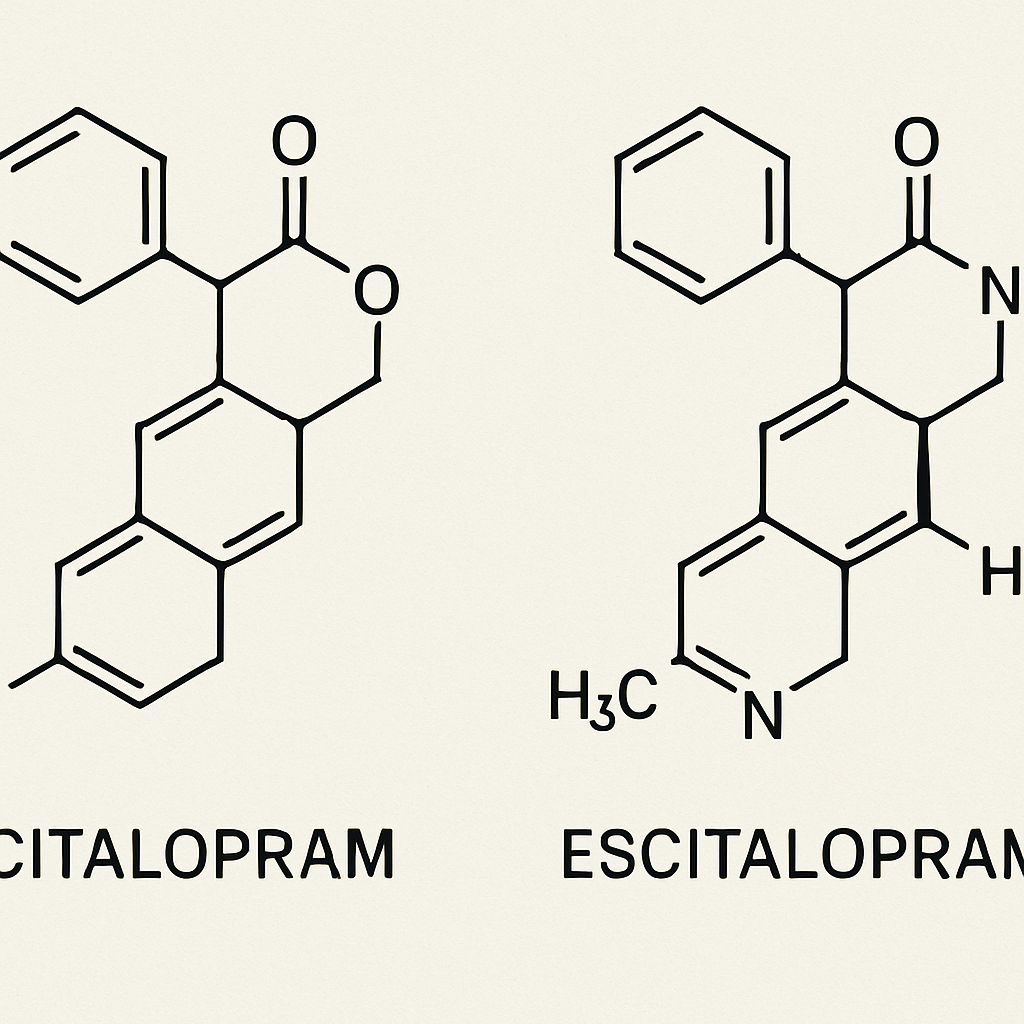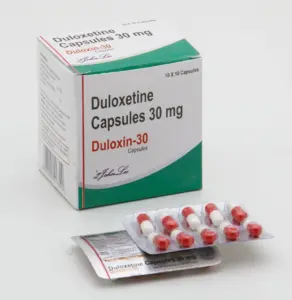Understanding the difference between citalopram and escitalopram can significantly impact your mental health treatment choices. Both medications fall under the category of selective serotonin reuptake inhibitors (SSRIs) and are predominantly used to manage depression and anxiety disorders. However, there are notable distinctions between them that can influence their suitability for different individuals. This comprehensive article delves deeper into their effectiveness, uses, side effects, and other vital factors, aiming to guide you in determining the better option for your unique needs.
Citalopram and escitalopram are part of the broader class of selective serotonin reuptake inhibitors (SSRIs), commonly prescribed for mental health conditions like depression and anxiety. These medications function by increasing the serotonin levels in the brain, a neurotransmitter essential for mood regulation.
SSRIs, including citalopram and escitalopram, are widely prescribed due to their efficacy and generally favorable side effect profile. They work by blocking the reabsorption (reuptake) of serotonin in the brain, making more serotonin available. This increase in serotonin levels can improve mood and emotional balance.
Serotonin is often called the “feel-good” neurotransmitter. It plays a vital role in mood regulation, anxiety, and happiness. By enhancing serotonin levels, SSRIs can help alleviate symptoms of depression and anxiety, leading to improved mental health outcomes.
Beyond depression and anxiety, SSRIs like citalopram and escitalopram are sometimes used to treat a variety of other conditions. These can include obsessive-compulsive disorder (OCD), panic disorder, and post-traumatic stress disorder (PTSD). Their versatility makes them a staple in psychiatric treatment.
Citalopram, sold under the brand name Celexa, has been widely utilized to address depression and related symptoms. Known for its effectiveness, it can significantly improve mood, sleep, and energy levels.
Citalopram works by blocking the reuptake of serotonin in the brain, thereby increasing its availability. This action helps elevate mood and alleviate depressive symptoms. Its efficacy in treating anxiety disorders and panic attacks is also recognized, making it a versatile option for mental health treatment.
Patients using citalopram often report improvements in mood and overall well-being. It is particularly effective in stabilizing mood swings and reducing anxiety levels. Many individuals also experience better sleep patterns and increased energy, contributing to an enhanced quality of life.
While citalopram is effective for many, it may not be suitable for everyone. Factors such as pre-existing health conditions, potential drug interactions, and individual response to medication can influence its efficacy. It’s crucial to have a thorough discussion with a healthcare provider before starting treatment.
Escitalopram, known by the brand name Lexapro, is highly regarded for its rapid onset of action and superior efficacy in treating anxiety symptoms compared to some other SSRIs.
Similar to citalopram, escitalopram enhances serotonin levels by inhibiting its reuptake in the brain. However, as the S-enantiomer of citalopram, it offers a more targeted approach, potentially leading to better outcomes in treating anxiety and depression.
One of the primary advantages of escitalopram is its quick action. Patients often notice a reduction in anxiety symptoms sooner than with other SSRIs. Its targeted mechanism also means it can be effective at lower doses, reducing the risk of side effects.
While escitalopram is effective, some patients may experience side effects or find it less suitable due to individual differences. As with any medication, a personalized approach to treatment is essential, considering factors such as medical history and current medications.

The Key Differences
Citalopram and escitalopram, while similar, have distinct differences that can affect their use and efficacy in treatment.
Chemical Composition
The primary distinction between citalopram and escitalopram lies in their chemical structure. Escitalopram is essentially the S-enantiomer of citalopram, making it a more refined version. This subtle difference can impact how the drugs are metabolized and tolerated by different patients.
Effectiveness in Treatment
Research indicates that escitalopram may offer slightly higher efficacy, particularly for anxiety disorders. Its more focused action on serotonin reuptake is believed to contribute to this increased effectiveness. However, individual responses can vary, and what works best may differ from person to person.
Dosage Considerations
Citalopram is typically prescribed in doses ranging from 20 mg to 40 mg per day, whereas escitalopram is usually given at 10 mg to 20 mg per day. The lower dosage of escitalopram is due to its increased potency and targeted action, which can be beneficial for reducing side effects.
Uses and Indications
Both citalopram and escitalopram serve important roles in mental health treatment, but their specific uses can vary slightly.
Citalopram Uses
Citalopram is primarily indicated for major depressive disorder. However, it is also employed to manage:
- Panic disorders
- Obsessive-compulsive disorder (OCD)
- Social anxiety disorder
These applications highlight its versatility as a treatment option for various mental health issues.
Escitalopram Uses
Escitalopram is also used for major depressive disorder but shines in treating:
- Generalized anxiety disorder (GAD)
- Panic disorder
- Social anxiety disorder
Its effectiveness in anxiety-related conditions makes it a preferred choice for many patients.
Overlapping and Unique Indications
While both medications share some common uses, escitalopram’s enhanced efficacy in anxiety disorders sets it apart. This difference can be a deciding factor when choosing between the two, depending on the specific symptoms and conditions being treated.
Side Effects
Understanding the side effect profiles of citalopram and escitalopram is crucial for making an informed decision.
Citalopram Side Effects
Common side effects associated with citalopram include:
- Nausea
- Dry mouth
- Sleep disturbances
- Increased sweating
- Fatigue
These side effects can vary in intensity and may diminish over time as the body adjusts to the medication.
Escitalopram Side Effects
While escitalopram shares many side effects with citalopram, it is often reported to cause fewer instances of certain adverse effects, such as dry mouth and fatigue. Common side effects include:
- Nausea
- Insomnia
- Dizziness
- Increased sweating
- Sexual dysfunction
It’s important to monitor any side effects experienced and discuss them with a healthcare provider to manage them effectively.
Managing and Mitigating Side Effects
Patients can often manage side effects through lifestyle adjustments and by working closely with their healthcare provider. If side effects persist or become severe, alternative treatments may be considered to ensure optimal care and comfort.

Alternatives to Citalopram and Escitalopram
For individuals who do not tolerate citalopram or escitalopram well or who do not respond to treatment, several alternatives are available.
Other SSRIs
Alternatives within the SSRI class include fluoxetine (Prozac) and sertraline (Zoloft). These medications also increase serotonin levels but may have different side effect profiles or efficacy for certain individuals.
SNRIs and Other Antidepressants
Serotonin-norepinephrine reuptake inhibitors (SNRIs) like venlafaxine (Effexor) provide another option. These drugs target both serotonin and norepinephrine, offering a different approach to treating depression and anxiety.
Personalized Treatment Options
Ultimately, the best treatment is one tailored to the individual’s specific needs and responses. A healthcare provider can help navigate the options to find the most suitable medication or combination of therapies.
Patient Reviews and Experiences
Both citalopram and escitalopram have been extensively reviewed by patients, offering valuable insights into their real-world effectiveness and tolerability.
Escitalopram Patient Experiences
Many users of escitalopram report a quicker improvement in anxiety symptoms. This rapid onset can be particularly beneficial for those experiencing acute anxiety. Positive reviews often highlight improved mood and reduced anxiety, contributing to an enhanced quality of life.
Citalopram Patient Feedback
Citalopram users frequently mention its effectiveness in stabilizing mood over time. Reviews often emphasize improvements in energy levels and sleep quality, making it a reliable choice for long-term treatment of depression.
The Importance of Individual Experiences
While reviews can provide insights, individual responses to medication can vary widely. It’s essential to consider personal health history and work closely with a healthcare provider to determine the most appropriate treatment.
Making the Right Choice
Choosing between citalopram and escitalopram should be a collaborative process involving your healthcare provider.
Factors to Consider
Key factors to consider include:
- Your specific symptoms and diagnosis
- Side effect profiles of the medications
- Your personal health history
- Any other medications you’re currently taking
These considerations can guide a personalized treatment plan that aligns with your health goals.
Consulting with Healthcare Professionals
A thorough discussion with your healthcare provider is crucial. They can provide detailed information on each medication’s benefits and risks, helping you make an informed decision.
Monitoring and Adjusting Treatment
Once a medication is chosen, ongoing monitoring is essential. Regular check-ins with your healthcare provider can ensure that the treatment remains effective and any side effects are managed appropriately.
Conclusion
Understanding the difference between citalopram and escitalopram is a critical step in making informed decisions about mental health treatment. Both medications offer effective solutions, but their differences in chemical composition, effectiveness, and side effects may make one more suitable than the other for individual needs. Always consult with a healthcare professional to determine the best treatment option tailored to your specific requirements.



